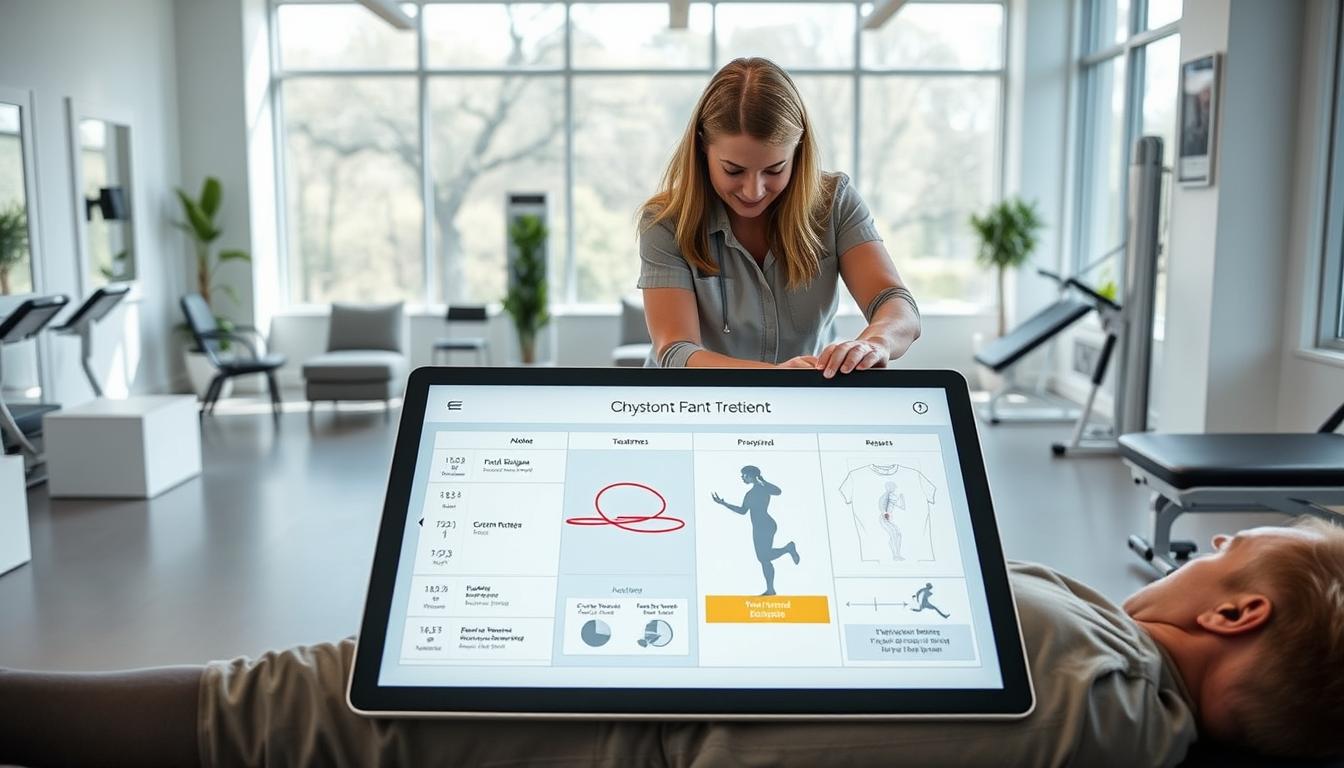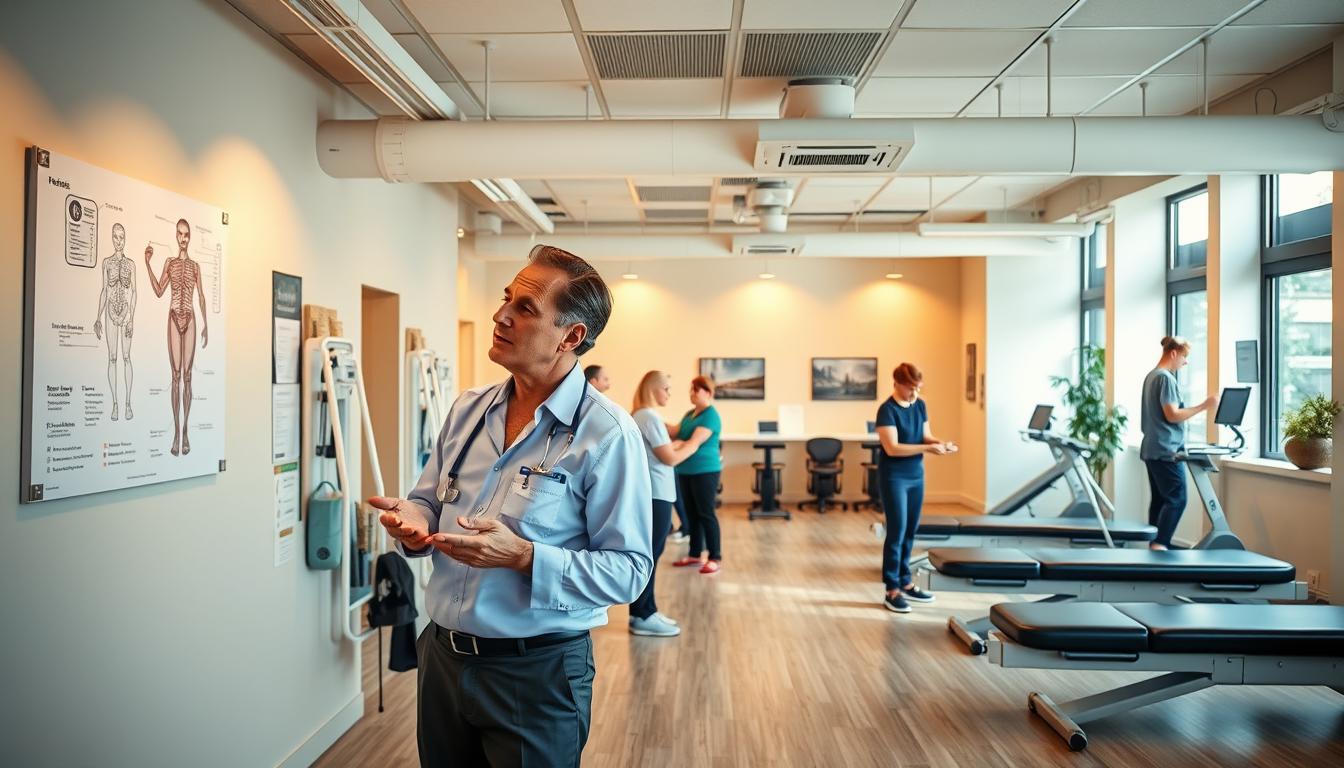Did you know that about 20% of adults in the United States live with chronic pain? This number shows how big of an issue low back pain and other conditions are. With over three million people in the U.S. dealing with chronic pain, finding good treatments is key. Physical therapy is becoming a top choice, helping people use less medicine, like opioids.
In this article, we’ll look at how physical therapy helps with pain. We’ll talk about different methods, plans made just for you, and exercises that really work. Research shows that physical therapy can cut pain in half, making it a big help in managing pain.
Also, using many different treatments can make life better for 75% of people with chronic pain. As we learn more, you’ll see how physical therapy can change how you deal with pain. It can help you get back to living an active life.
Key Takeaways
- Chronic pain impacts 20% of adults in the U.S., highlighting the need for effective treatments.
- Physical therapy can reduce pain levels significantly, providing a sustainable alternative to opioids.
- Multidisciplinary approaches enhance quality of life for many patients with chronic pain.
- Personalized treatment plans are key for successful pain relief strategies.
- Physical therapy improves functional mobility in patients, leading to a better overall experience.
The Role of Physical Therapy in Chronic Pain Management
Chronic pain affects about 100 million Americans each year. It greatly impacts their quality of life. Physical therapy helps manage chronic pain, easing discomfort and improving function.
Unlike acute pain, chronic pain lasts more than three to six months. Pain management physical therapy helps you regain daily function. It also improves your overall well-being.
Physical therapists teach you to move properly. This helps change how your body sends pain signals. They assess your range of motion, muscle strength, and more to create a personalized plan.
They use exercises to boost mobility and strengthen muscles. These include low-impact aerobic training and pain relief exercises. They also use dry needling, heat, ice, and massage for a complete pain relief approach.
Physical therapy is a key non-pharmacological option due to the opioid crisis. It helps you regain control over your body and pain. This way, you can do daily tasks and keep working.
Understanding Chronic Pain and Its Impact
Chronic pain affects about 50 million Americans, changing their daily lives and well-being. It lasts more than three months and can cause many problems. These include less activity, job loss, and financial issues from medical costs and lost wages.
Chronic pain also has a big emotional impact. Studies show it’s linked to anxiety and depression. This shows why we need to talk more about chronic pain, not just in hospitals but everywhere.
Long periods of rest can make things worse. It can lead to muscle weakness and poor blood flow. People might take more medicine, but it doesn’t solve the problem. They might feel stiff, have poor blood flow, and get weaker from not moving.
Many people suffer from chronic low-back pain. This pain can make it hard to move and keep the spine stable. Physical therapy is a good way to manage pain without medicine. The American Physical Therapy Association says treating pain early helps improve life and cuts down on medicine use.
Physical Therapy for Pain Relief
Physical therapy is often suggested by doctors to help with pain from different conditions. It involves various treatments to improve how our bodies move and function. Through specific exercises and movements, it helps with both short-term and long-term pain.
What is Physical Therapy?
Physical therapy is about custom treatments that include manual therapies, exercises, and education. These help restore function and improve movement. Physical therapists, after years of study, are experts in managing pain and helping with injuries.
How It Addresses Pain Mechanisms
Physical therapy uses several ways to help with pain, like restoring balance and improving movement. Regular exercise is a big part of it and can greatly reduce pain. Personalized plans help with recovery and prevent future problems.
It also teaches about pain, which can change how people see it. This can help them recover faster. Plus, it tackles mental issues like anxiety and fear, making it a full approach to better health.
Benefits of Physical Therapy for Pain Relief
Physical therapy does more than just ease pain. It boosts your mobility and strength. It also helps manage pain over time without needing medicine. This way, you learn to handle pain on your own, cutting down on drug use.
Improved Mobility and Strength
Physical therapy has many benefits for your body. It helps you move better and get stronger. With a plan made just for you, you can see big improvements in how you feel and move.
Studies show a 60% boost in fitness from these programs. Getting stronger means you’re less likely to feel pain. This lets you live a more active life.
Long-term Pain Control Without Opioids
Opioids can be dangerous, leading to addiction and side effects. Physical therapy is a safer choice for managing pain. It’s as good as surgery for some problems, like knee or back pain.
By doing physical therapy, you can cut your pain by 40-50%. This means lasting relief without strong drugs.
Common Physical Therapy Techniques for Pain Relief
There are many ways to relieve pain through physical therapy. Each method helps in healing, restoring function, and improving life quality. Myofascial release, dry needling, and electrical stimulation are some of the most effective. Knowing about these can help you pick the best for your needs.
Myofascial Release
Myofascial release targets the fascia, the tissue around muscles. It helps reduce pain and improve movement. By applying gentle pressure, it relaxes tight areas and helps restore function. Many people find it helps them manage pain better and move more easily.
Dry Needling
Dry needling aims at muscle trigger points where pain starts. It uses thin needles to stimulate these areas. This increases blood flow and lowers muscle tension. Patients often see a drop in pain and better function after treatment.
Electrical Stimulation
Electrical stimulation uses impulses to block pain signals to the brain. It can give quick pain relief and aid in muscle recovery. Techniques like TENS are effective for both short-term and long-term pain. Adding electrical stimulation to your treatment can lead to better pain management and mobility.
Physical Therapy Exercises for Pain Relief
Adding physical therapy exercises to your routine can really help with pain, like back pain. Doing specific exercises can make you more flexible, stronger, and move better. Here are some important types of exercises you might find in physical therapy.
Low-impact Aerobic Training
Walking, swimming, and cycling are great for those who want to avoid chronic pain. They’re easy on the joints but good for your heart. Doing these regularly can cut back pain by up to 50%, making them key for pain relief.
Stretching and Strengthening Exercises
Stretching, like hamstring and quad stretches, and strengthening, like squats and lunges, can really help. They make you more flexible and less stiff. Doing these exercises can make your muscles work better over time. It’s best to do strengthening exercises often, focusing on weak spots that cause pain.
Targeted Pain Relief Exercises
There are exercises made just for pain, like spinal conditioning and stretches. Activities like the shoulder blade squeeze and seated lower back stretch are important. Doing these exercises as advised can help manage pain and improve your life.
The Importance of a Personalized Treatment Plan
Creating personalized physical therapy plans is key for managing pain effectively. Your unique medical history, pain levels, and abilities are considered. This approach is far better than a one-size-fits-all method.
Studies show physical therapy can relieve pain in 84% of cases. Custom plans consider your specific pain levels. They use various methods to help you recover.
It’s important to talk regularly with your therapist. This helps adjust your plan as needed. Learning self-care techniques also boosts your commitment to the plan.
Finding the Best Physical Therapy for Pain Relief
Dealing with chronic pain means you need to find the right physical therapy. It’s important to think about several things when choosing. Making a good choice can make a big difference in how you feel.
What to Look for in a Physical Therapist
When picking a physical therapist, look at their background and experience. Here are some important points to consider:
- Check if they are licensed and have the right education in physical therapy.
- See if they have experience with your kind of pain or injury.
- Find out if they use proven treatment methods.
- Make sure they communicate well and work with you to create a plan.
Types of Certifications and Specializations
Look at the certifications and specializations a physical therapist has. These can show they know a lot about managing pain:
- They might specialize in orthopedics, neuroscience, or sports medicine.
- They could be certified in manual therapy, like myofascial release or dry needling.
- They might have extra training in pain management.
- They could use treatments like electrical stimulation or ultrasound therapy.
Choosing a physical therapist with the right qualifications can help you manage your pain better.
The Therapeutic Alliance: Building Trust with Your Therapist
A strong bond between you and your therapist is key in physical therapy, mainly for pain management. This relationship greatly affects how well you do in treatment. Studies show that a strong connection makes you more likely to follow treatment plans and work harder on your recovery.
Good communication is essential for building this bond. Issues like power imbalances, tight schedules, and stress can make talking hard. By understanding these obstacles, you can push for a better environment where your voice is heard and valued.
The GRRRR model helps strengthen this relationship. It stands for Greeting, Respectful Listening, Review, Request, and Reward. When your therapist uses this, it creates a space of respect and understanding, helping you heal and feel better.
When a strong bond is formed, like in cancer pain care, better pain checks lead to better treatments. Also, building trust early on in kids’ care cuts down on surgery cancellations and improves their experience.
In tough times, like palliative care for stroke patients, a strong bond is even more important. It helps with talking, planning care, and emotional support. This way, treatment can better match what the patient and their family want.
Research shows that a strong bond is not just good for mental health but also for physical therapy. Feeling connected with your therapist motivates you to take action and stick to your treatment plan.
Exploring Holistic Pain Relief Therapy Options
Chronic pain affects millions, impacting their lives in many ways. About 65% of Americans over 65 live with pain for over three months. Holistic pain relief therapy is becoming a key option for those looking for more help.
Holistic therapy focuses on overall well-being. It includes methods like acupuncture, massage, and mindfulness. Studies show acupuncture can help with back pain and migraines. Massage therapy is good for neck, shoulder, and fibromyalgia pain.
Mindfulness techniques, like cognitive-behavioral therapy and progressive muscle relaxation, also help. They can reduce pain and improve physical function. A treatment plan that includes these methods can lead to lasting relief and better health.
Yoga therapy, tai chi, and other mind-body practices are becoming more popular. They are recommended by health professionals to manage chronic pain. Exercise, tailored to your needs, is also important. It helps build strength and flexibility without putting too much strain on your body.
When exploring these options, it’s important to work with healthcare providers. They should understand pain management. Using different therapy methods together can help you take control of your health and improve your life.
Collaborative Care in Pain Management
Chronic pain can really change your life. It might affect your work, daily activities, and how you feel overall. Using a team approach to manage pain often leads to better results. This method brings together different healthcare providers to tackle your pain from all angles.
The Multidisciplinary Approach
Teamwork among specialists like physical therapists, doctors, and psychologists is key. They work together to create a detailed plan for managing your pain. For example, at Weill Cornell Medicine, they use new methods like the Vertiflex Superion device for spinal issues and spinal cord stimulation for nerve pain.
They combine effective medicines and physical therapy to fit your specific needs. This ensures you get the best care possible.
Partnering with Other Healthcare Providers
Good teamwork means constant communication among all healthcare professionals. This ensures you get smooth care from start to finish. Working together can also help manage symptoms better and reduce opioid use, which can lead to addiction and depression.
Being part of a team focused on your pain can really help. They aim to understand the causes of your pain and how it affects your life. This approach has been shown to make treatments more effective and improve your quality of life.
Comfort and Safety in Physical Therapy
Feeling comfortable during therapy is key to its success. Patients need to feel safe and relaxed to get the most from their sessions. Knowing what exercises you’ll do helps a lot.
When therapists explain what you’ll do, it helps ease worries. This way, you’re ready for what’s coming.
Talking often with your therapist is very important. Sharing how you feel helps them adjust your plan. This builds trust and makes therapy safer for you.
Using a mix of methods to manage pain can make therapy more comfortable. Techniques like manual therapy and heat treatments are tailored to your needs. They help control pain and are safe.
The goal is to make therapy both comfortable and safe. Regular checks and plans made just for you help a lot. This creates a healing space that supports your well-being.
Conclusion
This article shows how important physical therapy is for managing chronic pain. About 20% of adults in the U.S. deal with chronic pain. Personalized treatment plans can cut pain levels by 30-50% and improve mobility and life quality.
Studies show physical therapy helps with pain from osteoarthritis and fibromyalgia. It lets people do daily activities again. This is key to their well-being.
Physical therapy is more than a quick fix. It’s a key part of managing pain. Working with physical therapists can lead to better strength and flexibility. This means less need for pain meds.
People also feel less anxious and depressed. They can live more fully and overcome pain barriers.
Adding physical therapy to your pain management plan can greatly improve your life. It helps with both physical and mental health. Physical therapy is a great way to live a healthier, more active life.
FAQ
What conditions can physical therapy help with for pain management?
Physical therapy can help with many conditions like chronic pain, back pain, and joint pain. It also helps with sports injuries. It aims to improve your mobility and strength. It offers pain relief through customized treatment plans.
How long does it typically take to see results from physical therapy?
Seeing results from physical therapy varies. It depends on your condition, treatment goals, and how well you follow the exercises. Many start feeling better and moving easier in just a few sessions.
Is physical therapy a safe option for pain relief?
Yes, physical therapy is safe and non-invasive. It uses rehabilitation techniques to help you function better. It’s a good alternative to opioids, with fewer risks of side effects or addiction.
Can physical therapy be used alongside other treatments?
Absolutely. Physical therapy works well with other treatments like medication and massage. Using different approaches together can improve your pain management and recovery.
What should I expect during my first physical therapy session?
At your first session, the therapist will assess your pain and goals. They will then create a treatment plan just for you. This plan will be based on your specific needs.
Are there specific exercises I can do at home for pain relief?
Yes, your therapist can give you exercises to do at home. These might include low-impact exercises, stretching, and strengthening. They’re designed to help you feel better and move easier at home.
How do I find the right physical therapist for my needs?
Look for a therapist with the right credentials and experience. Check if they have worked with your type of pain. Ask for recommendations from your doctor or people you trust.
Is physical therapy effective for chronic pain?
Yes, physical therapy is very effective for chronic pain. It helps change how you feel pain, improves your movement, and teaches you how to manage pain long-term.
How does the therapeutic alliance impact my physical therapy experience?
A good relationship with your therapist is key. It builds trust and helps you communicate better. This makes you more likely to follow your treatment plan and actively work on managing your pain.
What additional therapies can support my physical therapy treatment?
Therapies like acupuncture, massage, and wellness coaching can help too. They offer more pain relief and support your overall health and well-being.
James Foster, PT is a licensed physical therapist with over 11 years of hands-on experience in helping individuals improve mobility and live pain-free. As a health writer, James shares expert advice, rehabilitation strategies, and wellness tips to empower readers toward healthier, stronger lives.





